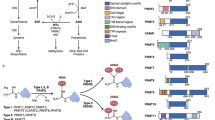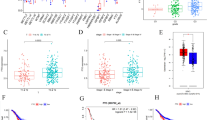Abstract
Histone post-translational modifications (HPTMs) play a major role in control of gene transcription. Among them, histone acetylation and methylation have been extensively investigated. Histone acetylation at different residues is generally associated to active gene transcription. In contrast, histone methylation can be associated either to transcriptional activation or repression, depending primarily on the histone residue that is subjected to the modification. Herein, effects of the histone deacetylase inhibitor SAHA on the sodium-iodide symporter (NIS) gene expression were investigated in breast cancer cells (MDA157 and MDA468). SAHA treatment induces high increase of NIS mRNA levels in MDA468 cells (300-fold), but moderate increase in MDA157 cells (fivefold). Histone H3 HPTMs (acetylation and methylations) on transcriptional units of NIS gene were investigated in these cell lines upon SAHA treatment. Our data indicate that HPTMs, particularly the H3 lysine 27 trimethylation, may operate in contrast to current models that relate epigenetic modifications with transcriptional activity.




Similar content being viewed by others
References
Turner BM (2000) Histone acetylation and an epigenetic code. BioEssays 22:836–845
Grunstein M (1997) Histone acetylation in chromatin structure and transcription. Nature 389:349–352
Berger SL (2007) The complex language of chromatin regulation during transcription. Nature 447:407–412
Shilatifard A (2006) Chromatin modifications by methylation and ubiquitination: implications in the regulation of gene expression. Annu Rev Biochem 75:243–269
Santos-Rosa H, Schneider R, Bernstein BE, Karabetsou N, Morillon A, Weise C, Schreiber SL, Mellor J, Kouzarides T (2003) Methylation of histone H3 K4 mediates association of the Isw1p ATPase with chromatin. Mol Cell 12:1325–1332
Ringrose L, Ehret H, Paro R (2004) Distinct contributions of histone H3 Lysine 9 and 27 methylation to locus-specific stability of polycomb complexes. Mol Cell 16:641–653
Barski A, Cuddapah S, Cui K, Roh TY, Schones DE, Wang Z, Wei G, Chepelev I, Zhao K (2007) High-resolution profiling of histone methylations in the human genome. Cell 129:823–837
Kurdistani SK, Tavazoie S, Grunstein M (2004) Mapping global histone acetylation patterns to gene expression. Cell 117:721–733
Mikkelsen TS, Ku M, Jaffe DB, Issac B, Lieberman E, Giannoukos G, Alvarez P, Brockman W, Kim TK, Koche RP, Lee W, Mendenhall E, O’Donovan A, Presser A, Russ C, Xie X, Meissner A, Wernig M, Jaenisch R, Nusbaum C, Lander ES, Bernstein BE (2007) Genome-wide maps of chromatin state in pluripotent and lineage-committed cells. Nature 448:553–560
Cui P, Liu W, Zhao Y, Lin Q, Zhang D, Ding F, Xin C, Zhang Z, Song S, Sun F, Yu J, Hu S (2012) Comparative analyses of H3K4 and H3K27 trimethylations between the mouse cerebrum and testis. Genomics Proteomics Bioinform 10:82–93
Dai G, Levy O, Carrasco N (1996) Cloning and characterization of the thyroid iodide transporter. Nature 379:458–460
Tazebay UH, Wapnir IL, Levy O, Dohan O, Zuckier LS, Zhao QH, Deng HF, Amenta PS, Fineberg S, Pestell RG, Carrasco N (2000) The mammary gland iodide transporter is expressed during lactation and in breast cancer. Nature Med 6:871–878
Renier C, Yao C, Goris M, Ghosh M, Katznelson L, Nowles K, Gambhir SS, Wapnir I (2009) Endogenous NIS expression in triple-negative breast cancers. Ann Surg Oncol 16:962–968
Taki K, Kogai T, Kanamoto Y, Hershman JM, Brent GA (2002) A thyroid-specific far-upstream enhancer in the human sodium/iodide symporter gene requires pax-8 binding and cyclic adenosine 3′-5′-monophosphate response element-like sequence binding proteins for full activity and is differentially regulated in normal and thyroid cancer cells. Mol Endocrinol 16:2266–2282
Kogai T, Brent GA (2012) The sodium iodide symporter (NIS): regulation and approaches to targeting for cancer therapeutics. Pharmacol Ther 135:355–370
Puppin C, D’Aurizio F, D’Elia AV, Cesaratto L, Tell G, Russo D, Filetti S, Ferretti E, Tosi E, Mattei T, Pianta A, Pellizzari L, Damante G (2005) Effects of histone acetylation on NIS promoter and expression of thyroid-specific transcription factors. Endocrinology 146:3967–3974
Fortunati N, Catalano MG, Marano F, Mugoni V, Pugliese M, Bosco O, Mainini F, Boccuzzi G (2010) The pan-DAC inhibitor LBH589 is a multi-functional agent in breast cancer cells: cytotoxic drug and inducer of sodium-iodide symporter (NIS). Breast Cancer Res Treat 124:667–675
Sponziello M, Scipioni A, Durante C, Verrienti A, Maranghi M, Giacomelli L, Ferretti E, Celano M, Filetti S, Russo D (2010) Regulation of sodium/iodide symporter and lactoperoxidase expression in four human breast cancer cell lines. J Endocrinol Invest 33:2–6
Marks PA, Xu WS (2009) Histone deacetylase inhibitors: potential in cancer therapy. J Cell Biochem 107:600–608
Russo D, Damante G, Puxeddu E, Durante C, Filetti S (2011) Epigenetics of thyroid cancer and novel therapeutic targets. J Mol Endocrinol 46:R73–R81
Akagi T, Luong QT, Gui D, Said J, Selektar J, Yung A, Bunce CM, Braunstein GD, Koeffler HP (2008) Induction of sodium iodide symporter gene and molecular characterisation of HNF3β/FoxA2, TTF-1 and C/EBPβ in thyroid carcinoma cells. Br J Cancer 99:781–788
Hou P, Bojdani E, Xing M (2010) Induction of thyroid gene expression and radioiodine uptake in thyroid cancer cells by targeting major signaling pathways. J Clin Endocrinol Metab 95:820–828
Marks PA (2007) Discovery and development of SAHA as an anticancer agent. Oncogene 26:1351–1356
Lavarone E, Puppin C, Passon N, Filetti S, Russo D, Damante G (2013) The PARP inhibitor PJ34 modifies proliferation, NIS expression and epigenetic marks in thyroid cancer cell lines. Mol Cell End 365:1–10
Bannister AJ, Kouzarides T (2011) Regulation of chromatin by histone modifications. Cell Res 21:381–395
Butler JS, Koutelou E, Schibler AC, Dent SY (2012) Histone-modifying enzymes: regulators of developmental decisions and drivers of human disease. Epigenomics 4:163–177
Rando OJ (2007) Global patterns of histone modifications. Curr Opin Genet Dev 17:94–99
Santos-Rosa H, Schneider R, Bannister AJ, Sherriff J, Bernstein BE, Emre NC, Schreiber SL, Mellor J, Kouzarides T (2002) Active genes are tri-methylated at K4 of histone H3. Nature 419:407–411
MacDonald VE, Howe LJ (2009) Histone acetylation: where to go and how to get there. Epigenetics 4:139–143
Hosogane M, Funayama R, Nishida Y, Nagashima T, Nakayama K (2013) Ras-induced changes in H3K27me3 occur after those in transcriptional activity. PLoS Genet 9:e1003698
Acknowledgments
This work is funded by grants to GD from Associazione Italiana per la Ricerca sul Cancro (AIRC) (project no IG 10296) and MIUR (20093WAPYK_003).
Author information
Authors and Affiliations
Corresponding author
Rights and permissions
About this article
Cite this article
Baldan, F., Lavarone, E., Di Loreto, C. et al. Histone post-translational modifications induced by histone deacetylase inhibition in transcriptional control units of NIS gene. Mol Biol Rep 41, 5257–5265 (2014). https://doi.org/10.1007/s11033-014-3397-x
Received:
Accepted:
Published:
Issue Date:
DOI: https://doi.org/10.1007/s11033-014-3397-x




